The USA The United States of America (also

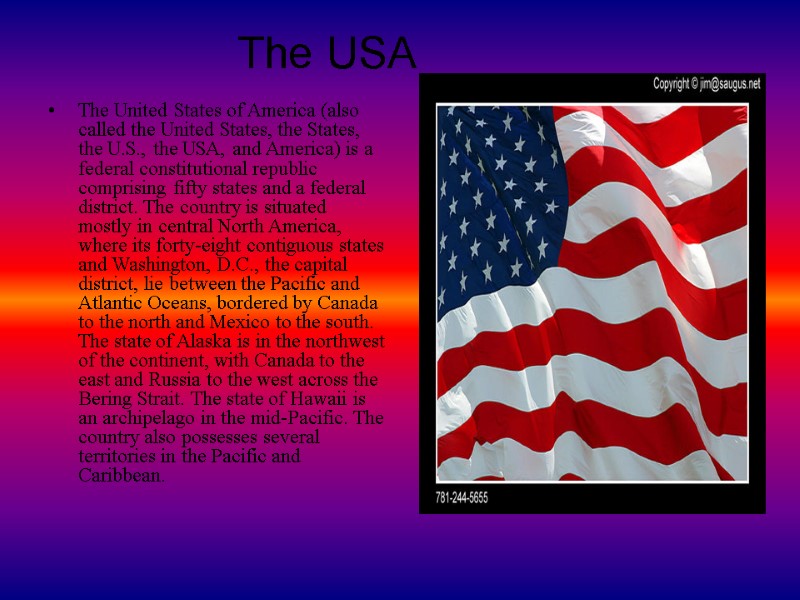
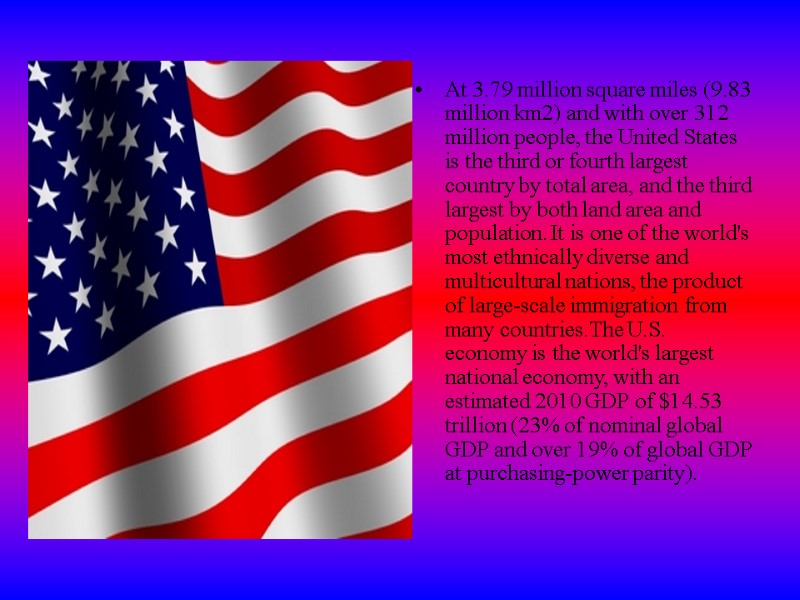
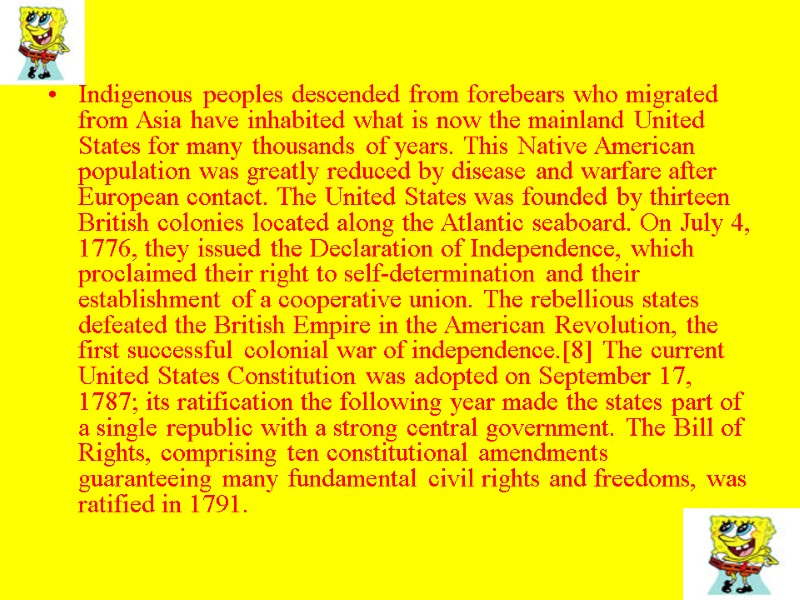
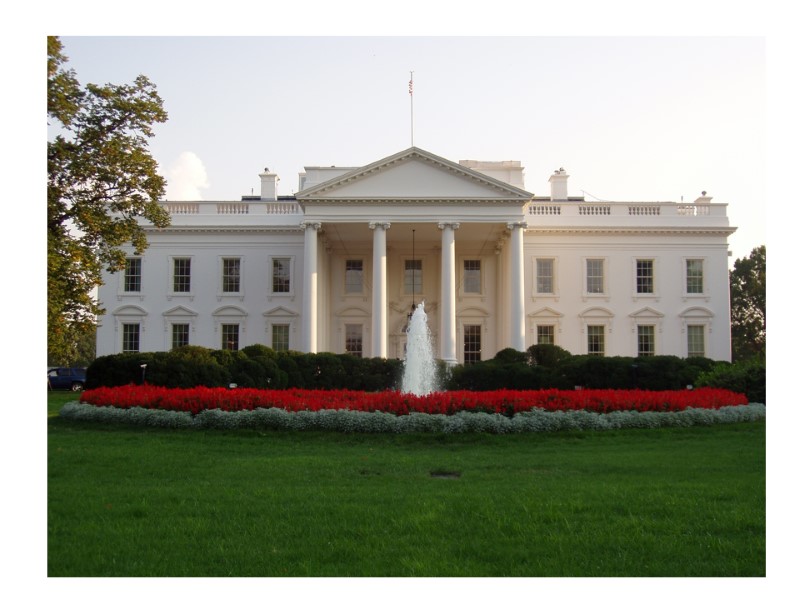
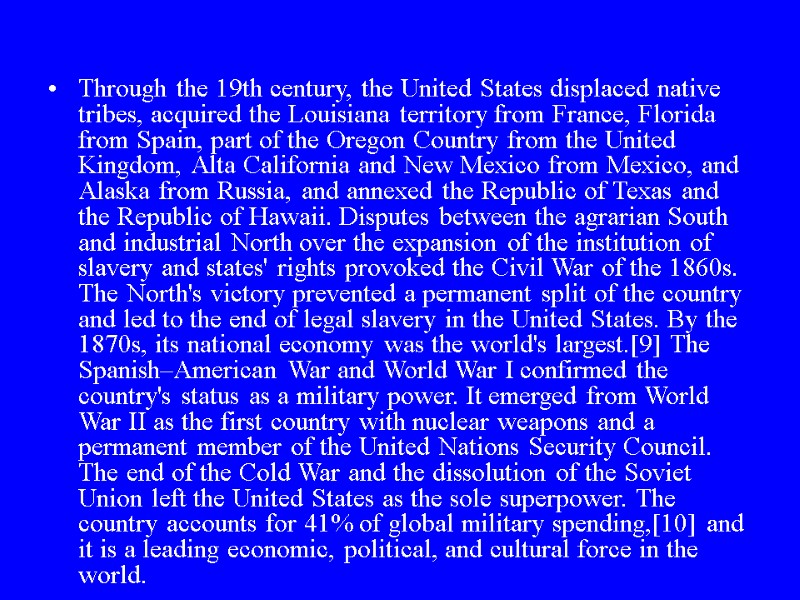
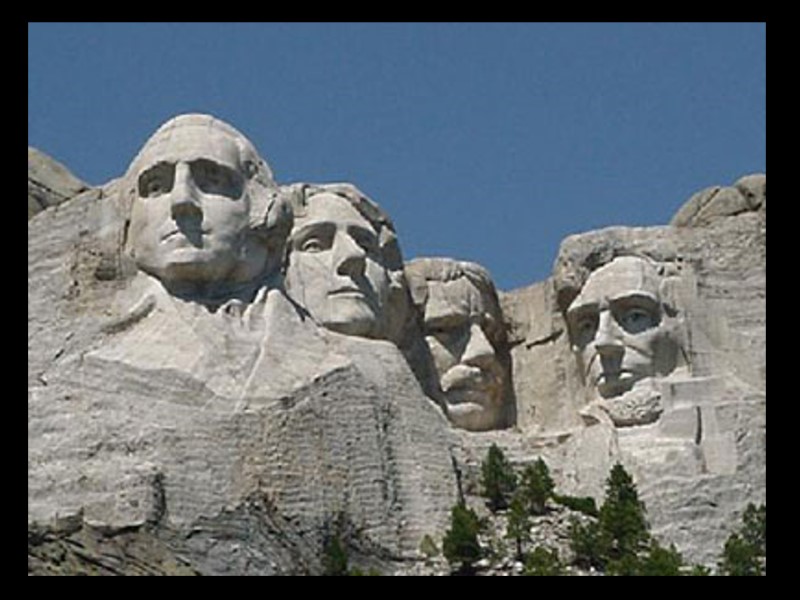
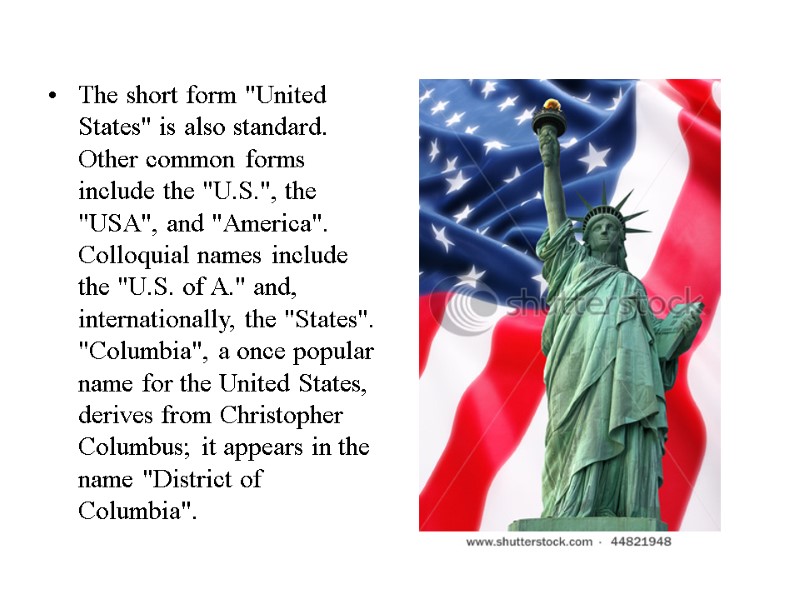
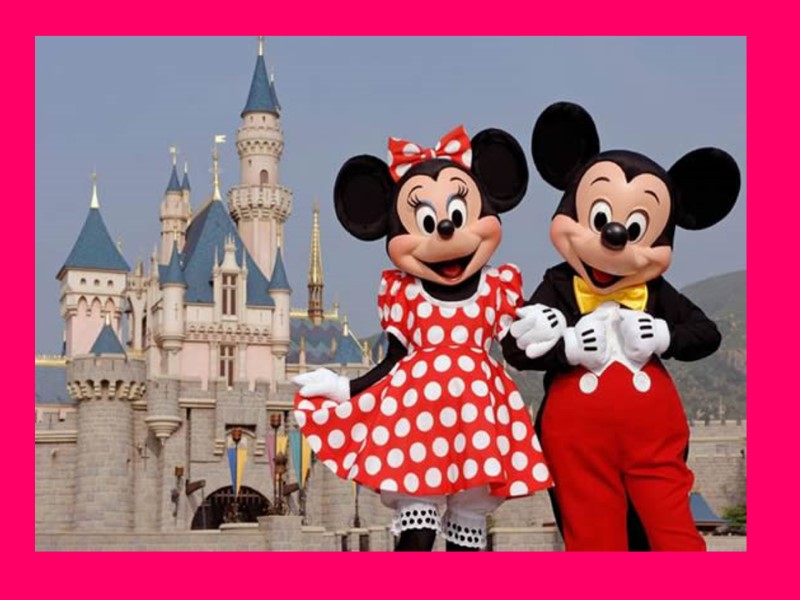
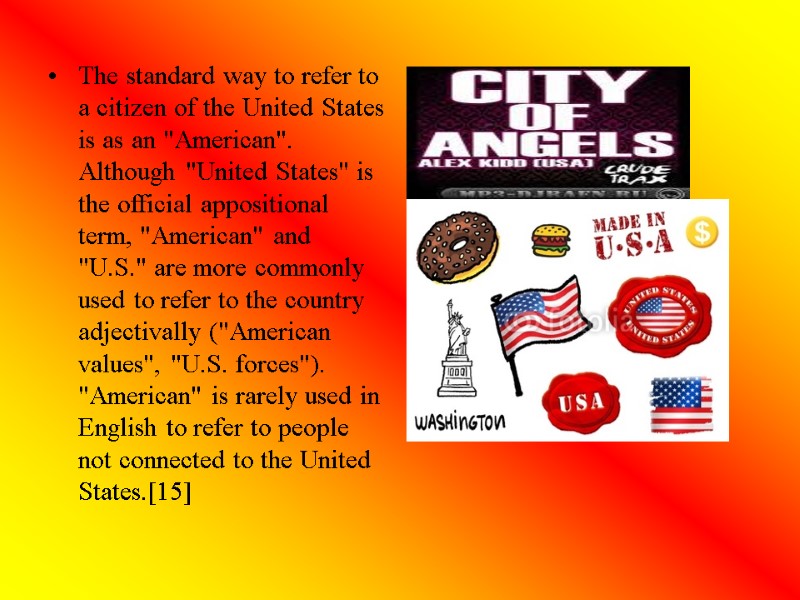
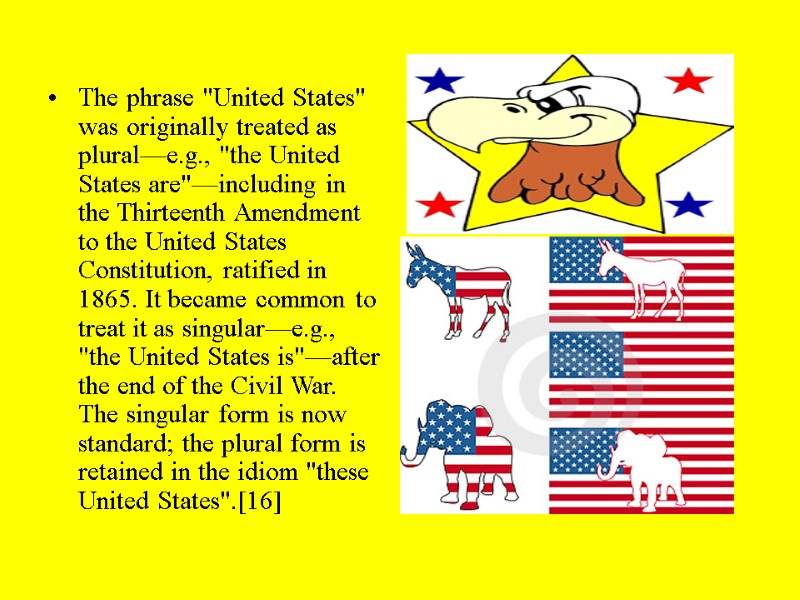
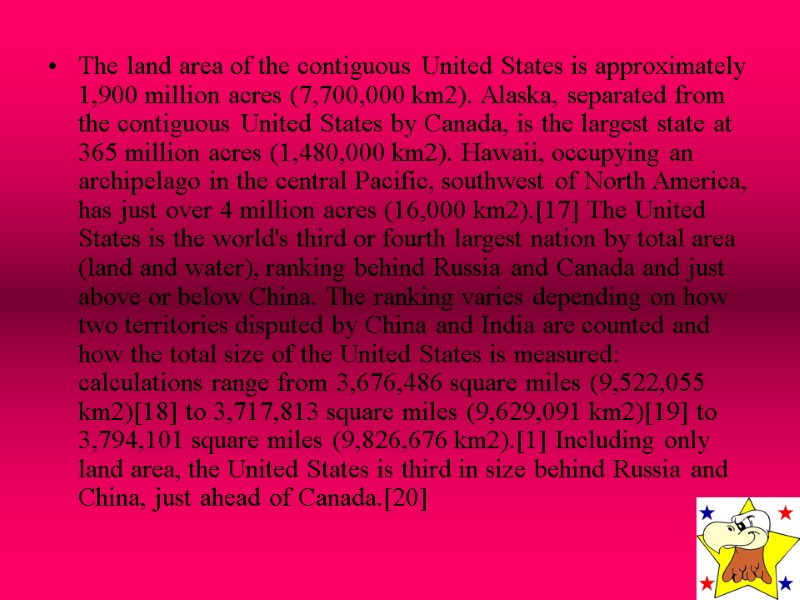
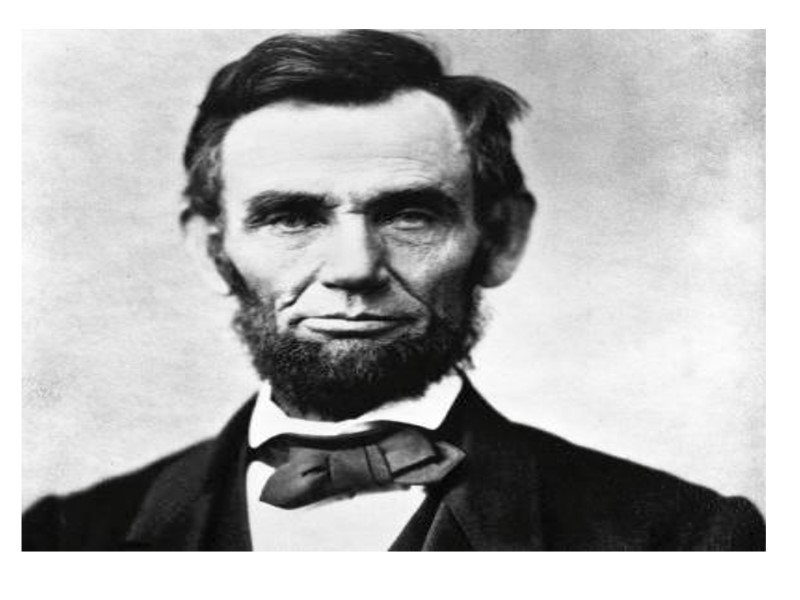
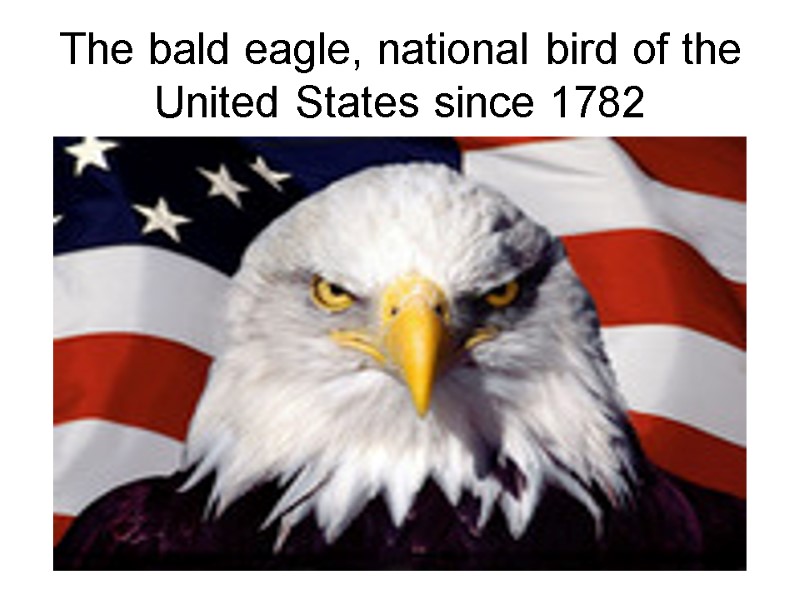
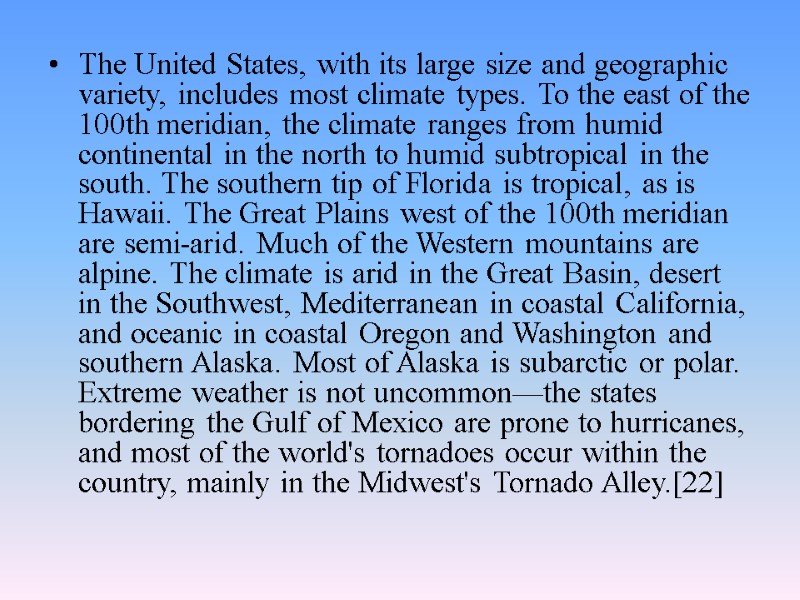
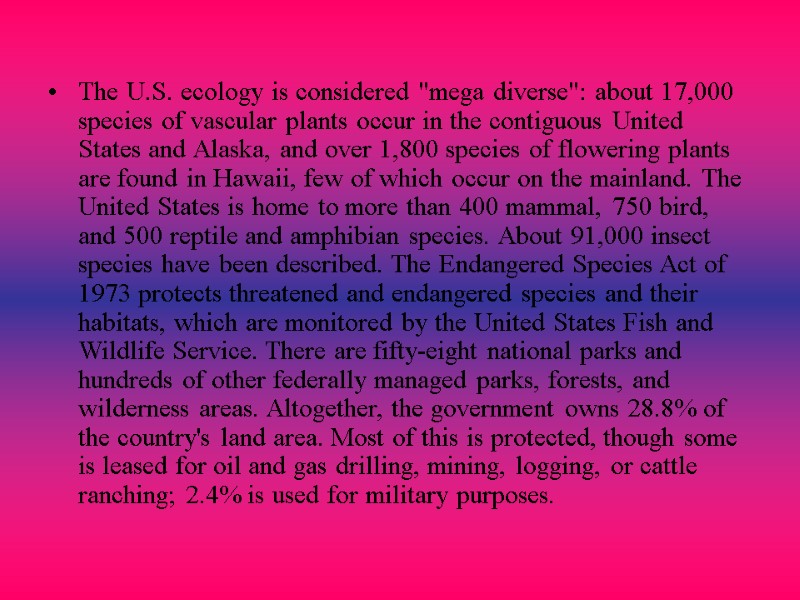
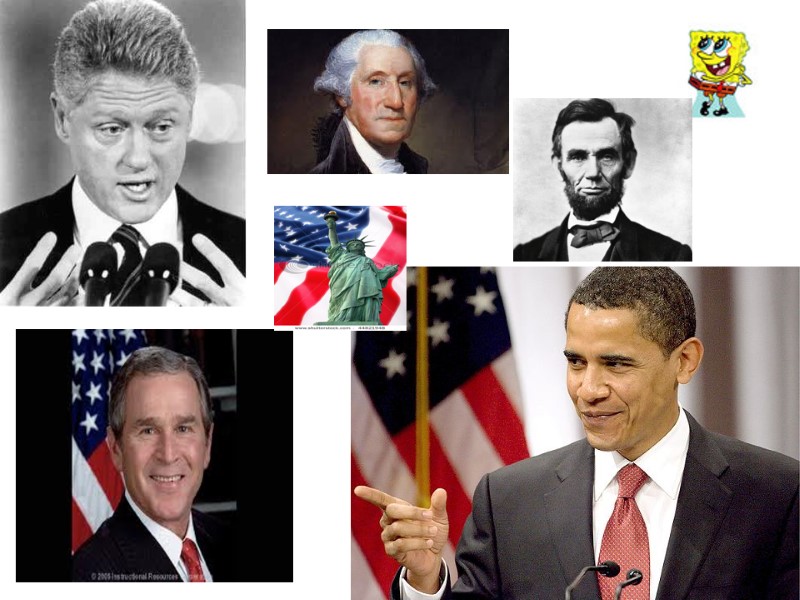
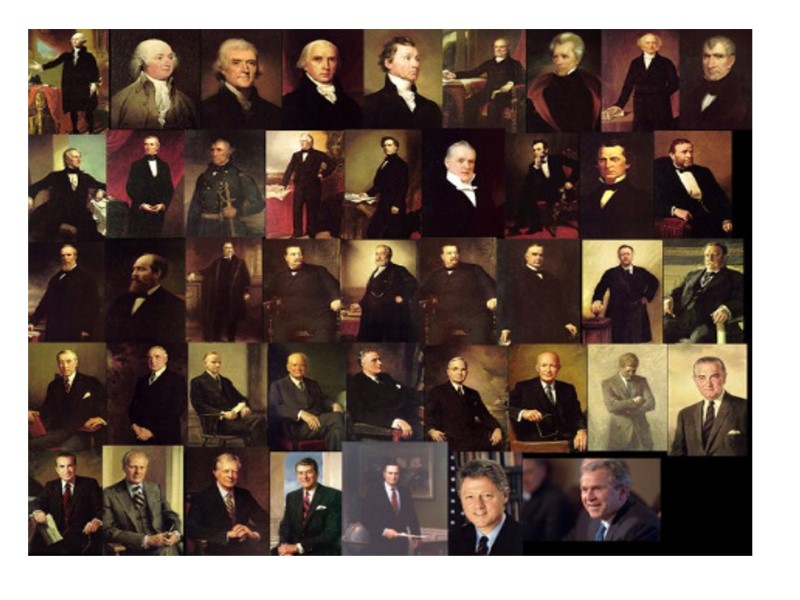
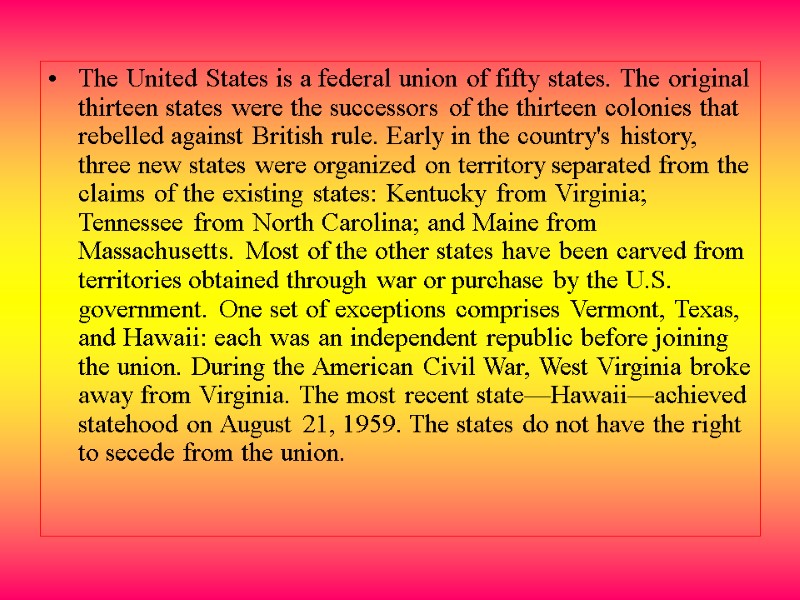
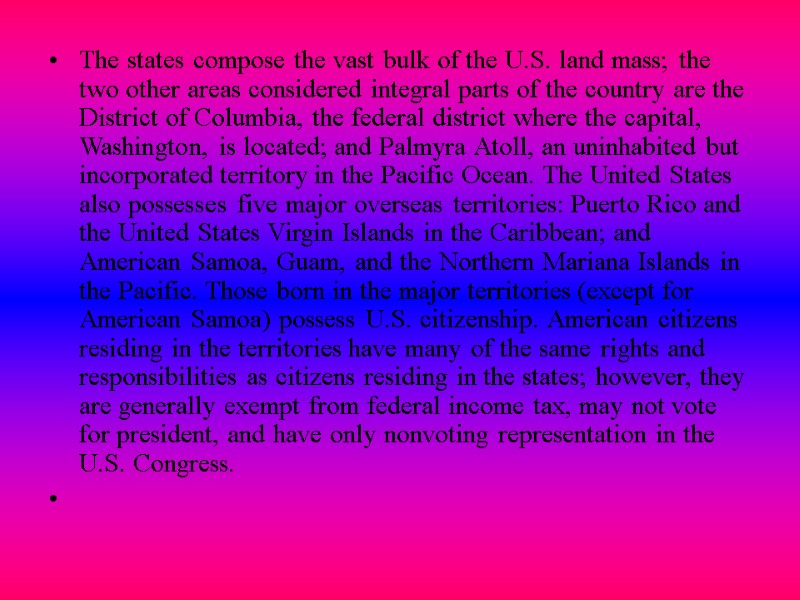
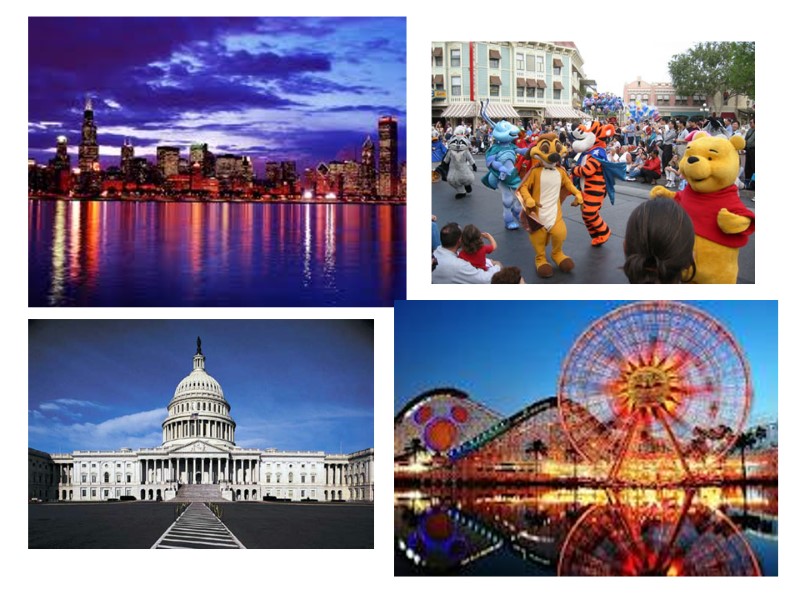
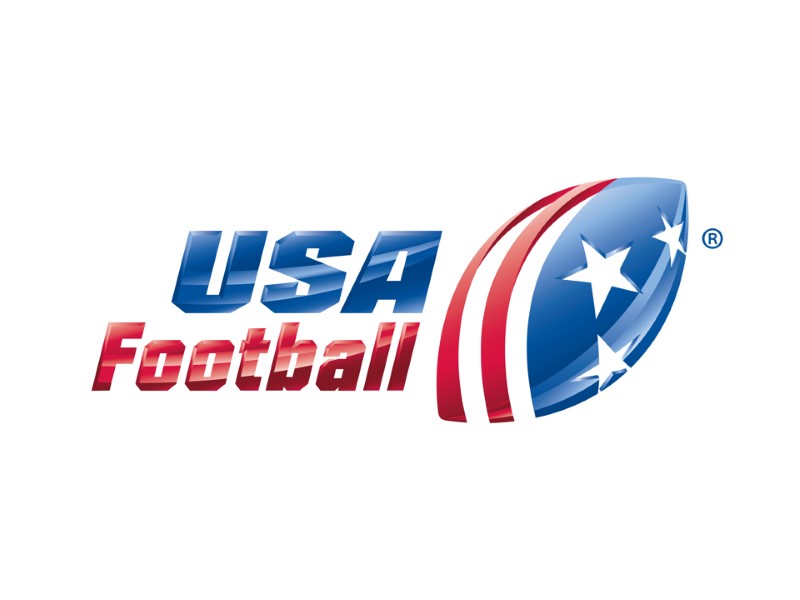

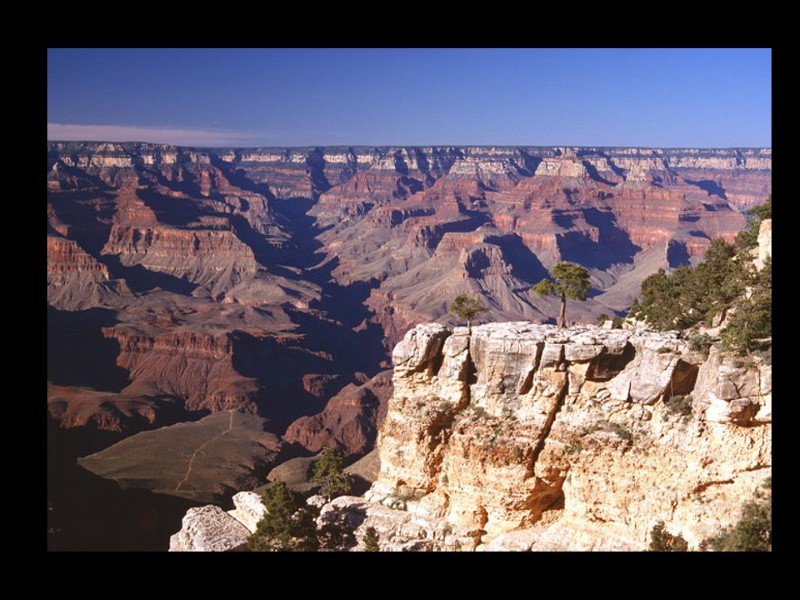


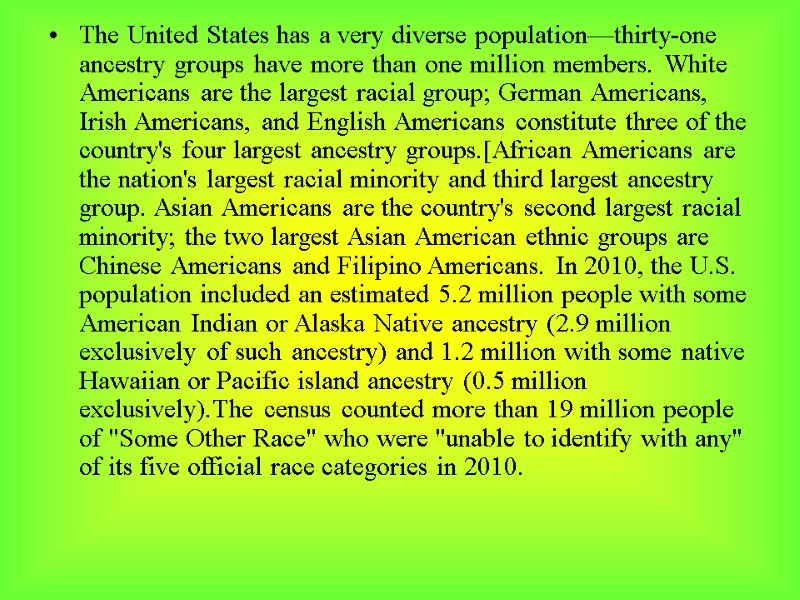
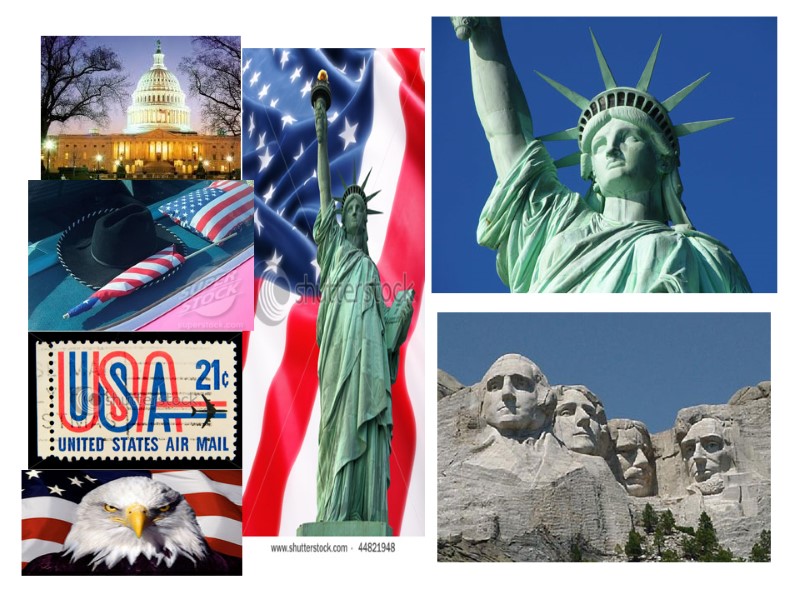

10894-the_usa01.ppt
- Количество слайдов: 28
 The USA The United States of America (also called the United States, the States, the U.S., the USA, and America) is a federal constitutional republic comprising fifty states and a federal district. The country is situated mostly in central North America, where its forty-eight contiguous states and Washington, D.C., the capital district, lie between the Pacific and Atlantic Oceans, bordered by Canada to the north and Mexico to the south. The state of Alaska is in the northwest of the continent, with Canada to the east and Russia to the west across the Bering Strait. The state of Hawaii is an archipelago in the mid-Pacific. The country also possesses several territories in the Pacific and Caribbean.
The USA The United States of America (also called the United States, the States, the U.S., the USA, and America) is a federal constitutional republic comprising fifty states and a federal district. The country is situated mostly in central North America, where its forty-eight contiguous states and Washington, D.C., the capital district, lie between the Pacific and Atlantic Oceans, bordered by Canada to the north and Mexico to the south. The state of Alaska is in the northwest of the continent, with Canada to the east and Russia to the west across the Bering Strait. The state of Hawaii is an archipelago in the mid-Pacific. The country also possesses several territories in the Pacific and Caribbean.
 At 3.79 million square miles (9.83 million km2) and with over 312 million people, the United States is the third or fourth largest country by total area, and the third largest by both land area and population. It is one of the world's most ethnically diverse and multicultural nations, the product of large-scale immigration from many countries.The U.S. economy is the world's largest national economy, with an estimated 2010 GDP of $14.53 trillion (23% of nominal global GDP and over 19% of global GDP at purchasing-power parity).
At 3.79 million square miles (9.83 million km2) and with over 312 million people, the United States is the third or fourth largest country by total area, and the third largest by both land area and population. It is one of the world's most ethnically diverse and multicultural nations, the product of large-scale immigration from many countries.The U.S. economy is the world's largest national economy, with an estimated 2010 GDP of $14.53 trillion (23% of nominal global GDP and over 19% of global GDP at purchasing-power parity).
 Indigenous peoples descended from forebears who migrated from Asia have inhabited what is now the mainland United States for many thousands of years. This Native American population was greatly reduced by disease and warfare after European contact. The United States was founded by thirteen British colonies located along the Atlantic seaboard. On July 4, 1776, they issued the Declaration of Independence, which proclaimed their right to self-determination and their establishment of a cooperative union. The rebellious states defeated the British Empire in the American Revolution, the first successful colonial war of independence.[8] The current United States Constitution was adopted on September 17, 1787; its ratification the following year made the states part of a single republic with a strong central government. The Bill of Rights, comprising ten constitutional amendments guaranteeing many fundamental civil rights and freedoms, was ratified in 1791.
Indigenous peoples descended from forebears who migrated from Asia have inhabited what is now the mainland United States for many thousands of years. This Native American population was greatly reduced by disease and warfare after European contact. The United States was founded by thirteen British colonies located along the Atlantic seaboard. On July 4, 1776, they issued the Declaration of Independence, which proclaimed their right to self-determination and their establishment of a cooperative union. The rebellious states defeated the British Empire in the American Revolution, the first successful colonial war of independence.[8] The current United States Constitution was adopted on September 17, 1787; its ratification the following year made the states part of a single republic with a strong central government. The Bill of Rights, comprising ten constitutional amendments guaranteeing many fundamental civil rights and freedoms, was ratified in 1791.

 Through the 19th century, the United States displaced native tribes, acquired the Louisiana territory from France, Florida from Spain, part of the Oregon Country from the United Kingdom, Alta California and New Mexico from Mexico, and Alaska from Russia, and annexed the Republic of Texas and the Republic of Hawaii. Disputes between the agrarian South and industrial North over the expansion of the institution of slavery and states' rights provoked the Civil War of the 1860s. The North's victory prevented a permanent split of the country and led to the end of legal slavery in the United States. By the 1870s, its national economy was the world's largest.[9] The Spanish–American War and World War I confirmed the country's status as a military power. It emerged from World War II as the first country with nuclear weapons and a permanent member of the United Nations Security Council. The end of the Cold War and the dissolution of the Soviet Union left the United States as the sole superpower. The country accounts for 41% of global military spending,[10] and it is a leading economic, political, and cultural force in the world.
Through the 19th century, the United States displaced native tribes, acquired the Louisiana territory from France, Florida from Spain, part of the Oregon Country from the United Kingdom, Alta California and New Mexico from Mexico, and Alaska from Russia, and annexed the Republic of Texas and the Republic of Hawaii. Disputes between the agrarian South and industrial North over the expansion of the institution of slavery and states' rights provoked the Civil War of the 1860s. The North's victory prevented a permanent split of the country and led to the end of legal slavery in the United States. By the 1870s, its national economy was the world's largest.[9] The Spanish–American War and World War I confirmed the country's status as a military power. It emerged from World War II as the first country with nuclear weapons and a permanent member of the United Nations Security Council. The end of the Cold War and the dissolution of the Soviet Union left the United States as the sole superpower. The country accounts for 41% of global military spending,[10] and it is a leading economic, political, and cultural force in the world.

 The short form "United States" is also standard. Other common forms include the "U.S.", the "USA", and "America". Colloquial names include the "U.S. of A." and, internationally, the "States". "Columbia", a once popular name for the United States, derives from Christopher Columbus; it appears in the name "District of Columbia".
The short form "United States" is also standard. Other common forms include the "U.S.", the "USA", and "America". Colloquial names include the "U.S. of A." and, internationally, the "States". "Columbia", a once popular name for the United States, derives from Christopher Columbus; it appears in the name "District of Columbia".

 The standard way to refer to a citizen of the United States is as an "American". Although "United States" is the official appositional term, "American" and "U.S." are more commonly used to refer to the country adjectivally ("American values", "U.S. forces"). "American" is rarely used in English to refer to people not connected to the United States.[15]
The standard way to refer to a citizen of the United States is as an "American". Although "United States" is the official appositional term, "American" and "U.S." are more commonly used to refer to the country adjectivally ("American values", "U.S. forces"). "American" is rarely used in English to refer to people not connected to the United States.[15]
 The phrase "United States" was originally treated as plural—e.g., "the United States are"—including in the Thirteenth Amendment to the United States Constitution, ratified in 1865. It became common to treat it as singular—e.g., "the United States is"—after the end of the Civil War. The singular form is now standard; the plural form is retained in the idiom "these United States".[16]
The phrase "United States" was originally treated as plural—e.g., "the United States are"—including in the Thirteenth Amendment to the United States Constitution, ratified in 1865. It became common to treat it as singular—e.g., "the United States is"—after the end of the Civil War. The singular form is now standard; the plural form is retained in the idiom "these United States".[16]
 The land area of the contiguous United States is approximately 1,900 million acres (7,700,000 km2). Alaska, separated from the contiguous United States by Canada, is the largest state at 365 million acres (1,480,000 km2). Hawaii, occupying an archipelago in the central Pacific, southwest of North America, has just over 4 million acres (16,000 km2).[17] The United States is the world's third or fourth largest nation by total area (land and water), ranking behind Russia and Canada and just above or below China. The ranking varies depending on how two territories disputed by China and India are counted and how the total size of the United States is measured: calculations range from 3,676,486 square miles (9,522,055 km2)[18] to 3,717,813 square miles (9,629,091 km2)[19] to 3,794,101 square miles (9,826,676 km2).[1] Including only land area, the United States is third in size behind Russia and China, just ahead of Canada.[20]
The land area of the contiguous United States is approximately 1,900 million acres (7,700,000 km2). Alaska, separated from the contiguous United States by Canada, is the largest state at 365 million acres (1,480,000 km2). Hawaii, occupying an archipelago in the central Pacific, southwest of North America, has just over 4 million acres (16,000 km2).[17] The United States is the world's third or fourth largest nation by total area (land and water), ranking behind Russia and Canada and just above or below China. The ranking varies depending on how two territories disputed by China and India are counted and how the total size of the United States is measured: calculations range from 3,676,486 square miles (9,522,055 km2)[18] to 3,717,813 square miles (9,629,091 km2)[19] to 3,794,101 square miles (9,826,676 km2).[1] Including only land area, the United States is third in size behind Russia and China, just ahead of Canada.[20]

 The bald eagle, national bird of the United States since 1782
The bald eagle, national bird of the United States since 1782
 The United States, with its large size and geographic variety, includes most climate types. To the east of the 100th meridian, the climate ranges from humid continental in the north to humid subtropical in the south. The southern tip of Florida is tropical, as is Hawaii. The Great Plains west of the 100th meridian are semi-arid. Much of the Western mountains are alpine. The climate is arid in the Great Basin, desert in the Southwest, Mediterranean in coastal California, and oceanic in coastal Oregon and Washington and southern Alaska. Most of Alaska is subarctic or polar. Extreme weather is not uncommon—the states bordering the Gulf of Mexico are prone to hurricanes, and most of the world's tornadoes occur within the country, mainly in the Midwest's Tornado Alley.[22]
The United States, with its large size and geographic variety, includes most climate types. To the east of the 100th meridian, the climate ranges from humid continental in the north to humid subtropical in the south. The southern tip of Florida is tropical, as is Hawaii. The Great Plains west of the 100th meridian are semi-arid. Much of the Western mountains are alpine. The climate is arid in the Great Basin, desert in the Southwest, Mediterranean in coastal California, and oceanic in coastal Oregon and Washington and southern Alaska. Most of Alaska is subarctic or polar. Extreme weather is not uncommon—the states bordering the Gulf of Mexico are prone to hurricanes, and most of the world's tornadoes occur within the country, mainly in the Midwest's Tornado Alley.[22]
 The U.S. ecology is considered "mega diverse": about 17,000 species of vascular plants occur in the contiguous United States and Alaska, and over 1,800 species of flowering plants are found in Hawaii, few of which occur on the mainland. The United States is home to more than 400 mammal, 750 bird, and 500 reptile and amphibian species. About 91,000 insect species have been described. The Endangered Species Act of 1973 protects threatened and endangered species and their habitats, which are monitored by the United States Fish and Wildlife Service. There are fifty-eight national parks and hundreds of other federally managed parks, forests, and wilderness areas. Altogether, the government owns 28.8% of the country's land area. Most of this is protected, though some is leased for oil and gas drilling, mining, logging, or cattle ranching; 2.4% is used for military purposes.
The U.S. ecology is considered "mega diverse": about 17,000 species of vascular plants occur in the contiguous United States and Alaska, and over 1,800 species of flowering plants are found in Hawaii, few of which occur on the mainland. The United States is home to more than 400 mammal, 750 bird, and 500 reptile and amphibian species. About 91,000 insect species have been described. The Endangered Species Act of 1973 protects threatened and endangered species and their habitats, which are monitored by the United States Fish and Wildlife Service. There are fifty-eight national parks and hundreds of other federally managed parks, forests, and wilderness areas. Altogether, the government owns 28.8% of the country's land area. Most of this is protected, though some is leased for oil and gas drilling, mining, logging, or cattle ranching; 2.4% is used for military purposes.


 The United States is a federal union of fifty states. The original thirteen states were the successors of the thirteen colonies that rebelled against British rule. Early in the country's history, three new states were organized on territory separated from the claims of the existing states: Kentucky from Virginia; Tennessee from North Carolina; and Maine from Massachusetts. Most of the other states have been carved from territories obtained through war or purchase by the U.S. government. One set of exceptions comprises Vermont, Texas, and Hawaii: each was an independent republic before joining the union. During the American Civil War, West Virginia broke away from Virginia. The most recent state—Hawaii—achieved statehood on August 21, 1959. The states do not have the right to secede from the union.
The United States is a federal union of fifty states. The original thirteen states were the successors of the thirteen colonies that rebelled against British rule. Early in the country's history, three new states were organized on territory separated from the claims of the existing states: Kentucky from Virginia; Tennessee from North Carolina; and Maine from Massachusetts. Most of the other states have been carved from territories obtained through war or purchase by the U.S. government. One set of exceptions comprises Vermont, Texas, and Hawaii: each was an independent republic before joining the union. During the American Civil War, West Virginia broke away from Virginia. The most recent state—Hawaii—achieved statehood on August 21, 1959. The states do not have the right to secede from the union.
 The states compose the vast bulk of the U.S. land mass; the two other areas considered integral parts of the country are the District of Columbia, the federal district where the capital, Washington, is located; and Palmyra Atoll, an uninhabited but incorporated territory in the Pacific Ocean. The United States also possesses five major overseas territories: Puerto Rico and the United States Virgin Islands in the Caribbean; and American Samoa, Guam, and the Northern Mariana Islands in the Pacific. Those born in the major territories (except for American Samoa) possess U.S. citizenship. American citizens residing in the territories have many of the same rights and responsibilities as citizens residing in the states; however, they are generally exempt from federal income tax, may not vote for president, and have only nonvoting representation in the U.S. Congress.
The states compose the vast bulk of the U.S. land mass; the two other areas considered integral parts of the country are the District of Columbia, the federal district where the capital, Washington, is located; and Palmyra Atoll, an uninhabited but incorporated territory in the Pacific Ocean. The United States also possesses five major overseas territories: Puerto Rico and the United States Virgin Islands in the Caribbean; and American Samoa, Guam, and the Northern Mariana Islands in the Pacific. Those born in the major territories (except for American Samoa) possess U.S. citizenship. American citizens residing in the territories have many of the same rights and responsibilities as citizens residing in the states; however, they are generally exempt from federal income tax, may not vote for president, and have only nonvoting representation in the U.S. Congress.


 The United States has many competitive private and public institutions of higher education. According to prominent international rankings, 13 or 15 American colleges and universities are ranked among the top 20 in the world. There are also local community colleges with generally more open admission policies, shorter academic programs, and lower tuition. Of Americans twenty-five and older, 84.6% graduated from high school, 52.6% attended some college, 27.2% earned a bachelor's degree, and 9.6% earned graduate degrees. The basic literacy rate is approximately 99%. The United Nations assigns the United States an Education Index of 0.97, tying it for 12th in the world.
The United States has many competitive private and public institutions of higher education. According to prominent international rankings, 13 or 15 American colleges and universities are ranked among the top 20 in the world. There are also local community colleges with generally more open admission policies, shorter academic programs, and lower tuition. Of Americans twenty-five and older, 84.6% graduated from high school, 52.6% attended some college, 27.2% earned a bachelor's degree, and 9.6% earned graduate degrees. The basic literacy rate is approximately 99%. The United Nations assigns the United States an Education Index of 0.97, tying it for 12th in the world.

 Health Health care in the United States, Health care reform in the United States, and Health insurance in the United States The United States life expectancy of 78.3 years at birth is ranked 36th among 194 United Nations member states; while above the world average, it falls short of the overall figure in Western Europe.Increasing obesity in the United States and health improvements elsewhere have contributed to lowering the country's rank in life expectancy from 1987 to 2007, from 11th to 42nd in the world. The infant mortality rate of 6.37 per thousand places the United States 42nd out of 221 countries, above average but behind all of Western Europe.Approximately one-third of the adult population is obese and an additional third is overweight; the obesity rate, the highest in the industrialized world, has more than doubled in the last quarter-century. Obesity-related type 2 diabetes is considered epidemic by health care professionals.
Health Health care in the United States, Health care reform in the United States, and Health insurance in the United States The United States life expectancy of 78.3 years at birth is ranked 36th among 194 United Nations member states; while above the world average, it falls short of the overall figure in Western Europe.Increasing obesity in the United States and health improvements elsewhere have contributed to lowering the country's rank in life expectancy from 1987 to 2007, from 11th to 42nd in the world. The infant mortality rate of 6.37 per thousand places the United States 42nd out of 221 countries, above average but behind all of Western Europe.Approximately one-third of the adult population is obese and an additional third is overweight; the obesity rate, the highest in the industrialized world, has more than doubled in the last quarter-century. Obesity-related type 2 diabetes is considered epidemic by health care professionals.

 The United States has a very diverse population—thirty-one ancestry groups have more than one million members. White Americans are the largest racial group; German Americans, Irish Americans, and English Americans constitute three of the country's four largest ancestry groups.[African Americans are the nation's largest racial minority and third largest ancestry group. Asian Americans are the country's second largest racial minority; the two largest Asian American ethnic groups are Chinese Americans and Filipino Americans. In 2010, the U.S. population included an estimated 5.2 million people with some American Indian or Alaska Native ancestry (2.9 million exclusively of such ancestry) and 1.2 million with some native Hawaiian or Pacific island ancestry (0.5 million exclusively).The census counted more than 19 million people of "Some Other Race" who were "unable to identify with any" of its five official race categories in 2010.
The United States has a very diverse population—thirty-one ancestry groups have more than one million members. White Americans are the largest racial group; German Americans, Irish Americans, and English Americans constitute three of the country's four largest ancestry groups.[African Americans are the nation's largest racial minority and third largest ancestry group. Asian Americans are the country's second largest racial minority; the two largest Asian American ethnic groups are Chinese Americans and Filipino Americans. In 2010, the U.S. population included an estimated 5.2 million people with some American Indian or Alaska Native ancestry (2.9 million exclusively of such ancestry) and 1.2 million with some native Hawaiian or Pacific island ancestry (0.5 million exclusively).The census counted more than 19 million people of "Some Other Race" who were "unable to identify with any" of its five official race categories in 2010.

 The END
The END

